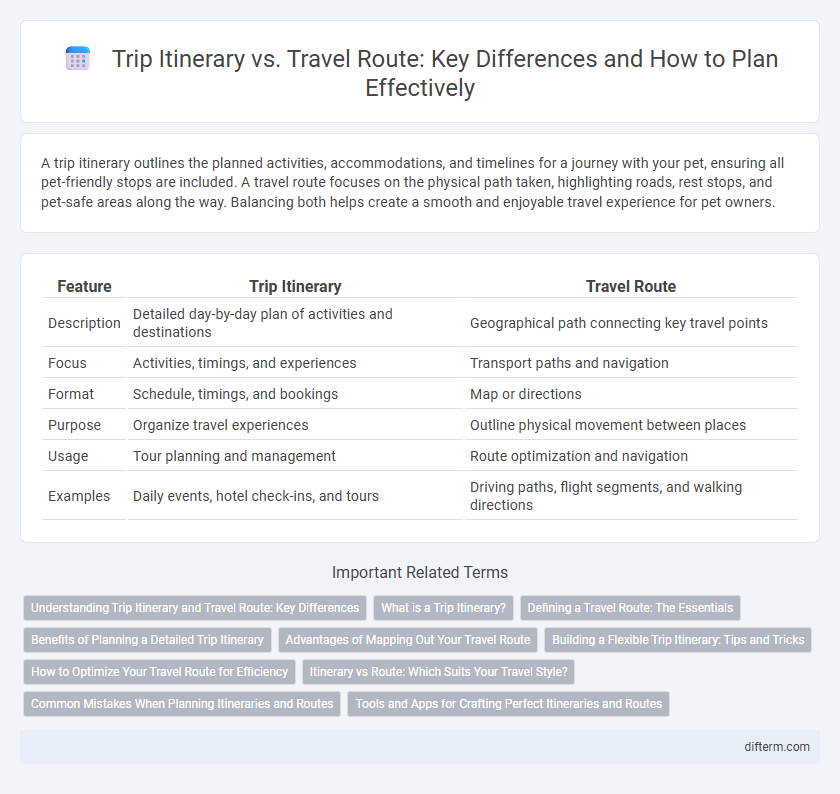A trip itinerary outlines the planned activities, accommodations, and timelines for a journey with your pet, ensuring all pet-friendly stops are included. A travel route focuses on the physical path taken, highlighting roads, rest stops, and pet-safe areas along the way. Balancing both helps create a smooth and enjoyable travel experience for pet owners.
Table of Comparison
| Feature | Trip Itinerary | Travel Route |
|---|---|---|
| Description | Detailed day-by-day plan of activities and destinations | Geographical path connecting key travel points |
| Focus | Activities, timings, and experiences | Transport paths and navigation |
| Format | Schedule, timings, and bookings | Map or directions |
| Purpose | Organize travel experiences | Outline physical movement between places |
| Usage | Tour planning and management | Route optimization and navigation |
| Examples | Daily events, hotel check-ins, and tours | Driving paths, flight segments, and walking directions |
Understanding Trip Itinerary and Travel Route: Key Differences
A trip itinerary outlines the planned schedule, activities, accommodations, and transportation details for each day of travel, offering a comprehensive framework for the entire journey. A travel route, by contrast, specifically maps the physical path or directions taken between destinations, emphasizing geographic navigation and transit options. Understanding these distinctions helps travelers balance detailed planning with efficient movement throughout their trip.
What is a Trip Itinerary?
A trip itinerary is a detailed plan outlining the schedule and activities for a specific travel period, including accommodations, transportation, and sightseeing stops. It serves as a comprehensive guide to organize daily plans, ensuring travelers maximize their time efficiently. Unlike a travel route that maps the physical path between destinations, an itinerary encompasses timing, reservations, and intended experiences throughout the journey.
Defining a Travel Route: The Essentials
A travel route defines the specific path or course taken from one destination to another, highlighting key waypoints and modes of transportation. Unlike a trip itinerary that includes activities, timings, and accommodations, a travel route emphasizes geographic progression and logistics. Precise mapping of the travel route ensures efficient navigation and optimal travel time management.
Benefits of Planning a Detailed Trip Itinerary
Planning a detailed trip itinerary enhances travel efficiency by organizing daily activities, accommodations, and transportation, minimizing unexpected delays and maximizing sightseeing opportunities. A well-structured itinerary helps travelers allocate time effectively, ensuring key attractions like museums, landmarks, and local experiences are prioritized. This detailed approach reduces stress and provides a clearer budget forecast, improving overall trip satisfaction.
Advantages of Mapping Out Your Travel Route
Mapping out your travel route enhances efficiency by highlighting the most direct and scenic paths, saving time and fuel costs. It allows for better planning of stops to explore local attractions, improving overall trip satisfaction. Optimized routes reduce the risk of getting lost, ensuring a smoother, stress-free travel experience.
Building a Flexible Trip Itinerary: Tips and Tricks
Building a flexible trip itinerary involves prioritizing key destinations while allowing buffer time for spontaneous activities or unexpected delays, enhancing overall travel experience. Incorporate multiple transportation options and local insights to adjust your travel route dynamically, ensuring seamless transitions between locations. Utilize digital tools like mobile apps or interactive maps to monitor real-time changes, enabling efficient itinerary modifications without compromising planned activities.
How to Optimize Your Travel Route for Efficiency
Optimizing your travel route for efficiency involves strategically planning destinations to minimize backtracking and reduce travel time between stops. Utilize mapping tools and GPS apps to identify the shortest path and avoid high-traffic areas during peak hours, ensuring smoother transitions. Incorporate time buffers for unexpected delays and schedule activities based on proximity and opening hours to maximize daily productivity.
Itinerary vs Route: Which Suits Your Travel Style?
An itinerary outlines planned activities, destinations, and timelines, ideal for travelers who prefer structure and detailed scheduling. A travel route emphasizes the physical path taken, catering to those who value flexibility and spontaneous exploration. Choosing between itinerary and route depends on your preference for organized plans or adaptable journeys during your travel experience.
Common Mistakes When Planning Itineraries and Routes
Confusing a trip itinerary with a travel route often leads to planning errors, such as underestimating travel times and overloading daily activities. Many travelers fail to account for transit delays, local traffic conditions, and rest periods, resulting in impractical schedules. Optimizing both the itinerary and route by integrating real-time transportation data and realistic timing enhances the travel experience and reduces stress.
Tools and Apps for Crafting Perfect Itineraries and Routes
Trip itinerary tools like TripIt and Sygic Travel streamline planning by organizing flights, accommodations, and activities into a cohesive schedule, while route apps such as Google Maps and Roadtrippers optimize navigation and uncover scenic or efficient paths. Integrating itinerary apps with navigation platforms ensures seamless transitions between planned events and travel routes, enhancing user experience. Leveraging features like real-time traffic updates, offline maps, and personalized suggestions allows travelers to craft precise and adaptable travel plans.
trip itinerary vs travel route Infographic

 difterm.com
difterm.com